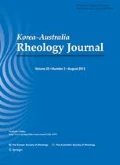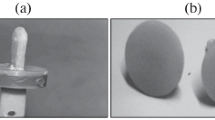Abstract
The purpose of this study is to determine and compare the handling and rheological properties of polyvinylsiloxane impression pastes before mixing and during setting, and to investigate the effect of its constituents on the properties of the materials. Five polyvinylsiloxane impression materials (Examixfine, Extrude, Honigum, Imprint II, and Express) were used. A flow test and a drip test were performed to determine the handling characteristics. The rheological properties of each impression material prior to mixing (shear stress, viscosity) and during setting (storage modulus G′), loss modulus G″), loss tangent tanδ) were measured with a stress-controlled rheometer at 25°C and 32°C, respectively. Inorganic filler content of each impression material was measured and observed with a SEM. The molecular weight distribution of polymer matrix was determined with a gel permeation chromatography (GPC). Express and Honigum display lower flow compared to the other materials, due to their high yield-stress values. Examixfine exhibits the greatest flow. All materials display pseudoplastic behavior, excluding the Examixfine catalyst. The viscosities at low shear rate are greatest for Express and Honigum; however, under high shear conditions, the viscosities of Extrude and Honigum are the lowest. Following mixing, each material show an increase in G′, finally reaching a plateau, and the tanδ rapidly decreases with time. Imprint II shows the highest final G′ as well as the most rapid decrease in tanδ. Express and Imprint II present the highest filler content and rough filler surface, while Honigum shows the lowest filler content and small filler particles. Most products are composed of polymers over 30 kDa and oligomers less than 1 kDa. Each impression material possesses different rheological properties, which significantly affect the handling characteristics. The yield stress of the impression material minimizes unnecessary flow prior to and after seating. Viscoelastic change during setting of each impression material determines the setting time and the stiffness after setting. These rheological properties of impression materials are affected by the filler content and molecular weight distribution of polymer matrix.
Similar content being viewed by others
References
Barnes, H.A., J.F. Hutton, and K. Walters, 1989, An introduction to rheology, Elsevier, Amsterdam.
Balkenhol, M.B., M. Wöstmann, and F.W.J. Kanehira, 2007, Shark fin test and impression quality: A correlation analysis, J. Dent. 35, 409–415.
Berg, J.C., G.H. Johnson, X. Lepe, and S. Adán-Plaza, 2003, Temperature effects on the rheological properties of current polyether and polysiloxane impression materials during setting, J. Prosthet Dent. 90, 150–161.
Braden, M., 1967, Viscosity and consistency of impression rubbers, J. Dent Res. 46, 429–433.
Combe, E.C. and J.B. Moser, 1978, The rheological characteristics of elastomeric impression materials, J. Dent Res. 57, 221–226.
Darvell, B.W., 2009, Materials science for dentistry, CRC Press, Washington DC.
German, M.J., T.E. Carrick, and J.F. McCabe, 2008, Surface detail reproduction of elastomeric impression materials related to rheological properties, Dent Mater. 24, 951–956.
Lee, I.B., H.H. Son, and C.M. Um, 2003, Rheologic properties of flowable, conventional hybrid, and condensable composite resins, Dent. Mater. 19, 298–307.
Lee, I.B., S.H. Min, S.Y. Kim, and J. Ferracane, 2010, Slumping tendency and rheological properties of flowable composites, Dent. Mater. 26, 443–448.
Lee, J.H., C.M. Um, and I.B. Lee, 2006, Rheological properties of resin composites according to variations in monomer and filler composition, Dent. Mater. 22, 515–526.
Martinez, J.E., E.C. Combe, and I.J. Pesun, 2001, Rheological properties of vinyl polysiloxane impression pastes, Dent. Mater. 17, 471–476.
McCabe, J.F. and A.J. Browman, 1981, The rheological properties of dental impression materials, Br. Dent. J. 151, 179–183.
McCabe, J.F. and T.E. Carrick, 1989, Rheological properties of elastomers during setting, J. Dent. Res, 68, 1218–1222.
McCabe, J.F. and H. Arikawa, 1998, Rheological properties of elastomeric impression materials before and during setting, J. Dent. Res. 77, 1874–80.
Min, K.J., M. Lee, J. Son, and J.H. Lee, 2010, Rheology as a powerful tool for industrial material development, Korea-Aust. Rheol. J. 22, 1–10.
Park, E.K. and K.W. Song, 2010, Rheological evaluation of petroleum jelly as a base material in ointment and cream formulations with respect to rubbing onto the human body, Korea-Aust. Rheol. J. 22, 279–289.
Rubel, B.S., 2007, Impression materials: a comparative review of impression materials most commonly used in restorative dentistry, Dental Clinics of North America. 51, 629–642.
Samaniuk, J.R., J. Wang, T.W. Root, C.T. Scott, and D.J. Klingenberg, 2011, Rheology of concentrated biomass, Korea-Aust. Rheol. J. 23, 237–245.
Author information
Authors and Affiliations
Corresponding author
Rights and permissions
About this article
Cite this article
Lee, HO., Lee, IB. Rheological properties of polyvinylsiloxane impression materials before mixing and during setting related to handling characteristics. Korea-Aust. Rheol. J. 24, 211–219 (2012). https://doi.org/10.1007/s13367-012-0026-x
Received:
Revised:
Accepted:
Published:
Issue Date:
DOI: https://doi.org/10.1007/s13367-012-0026-x




